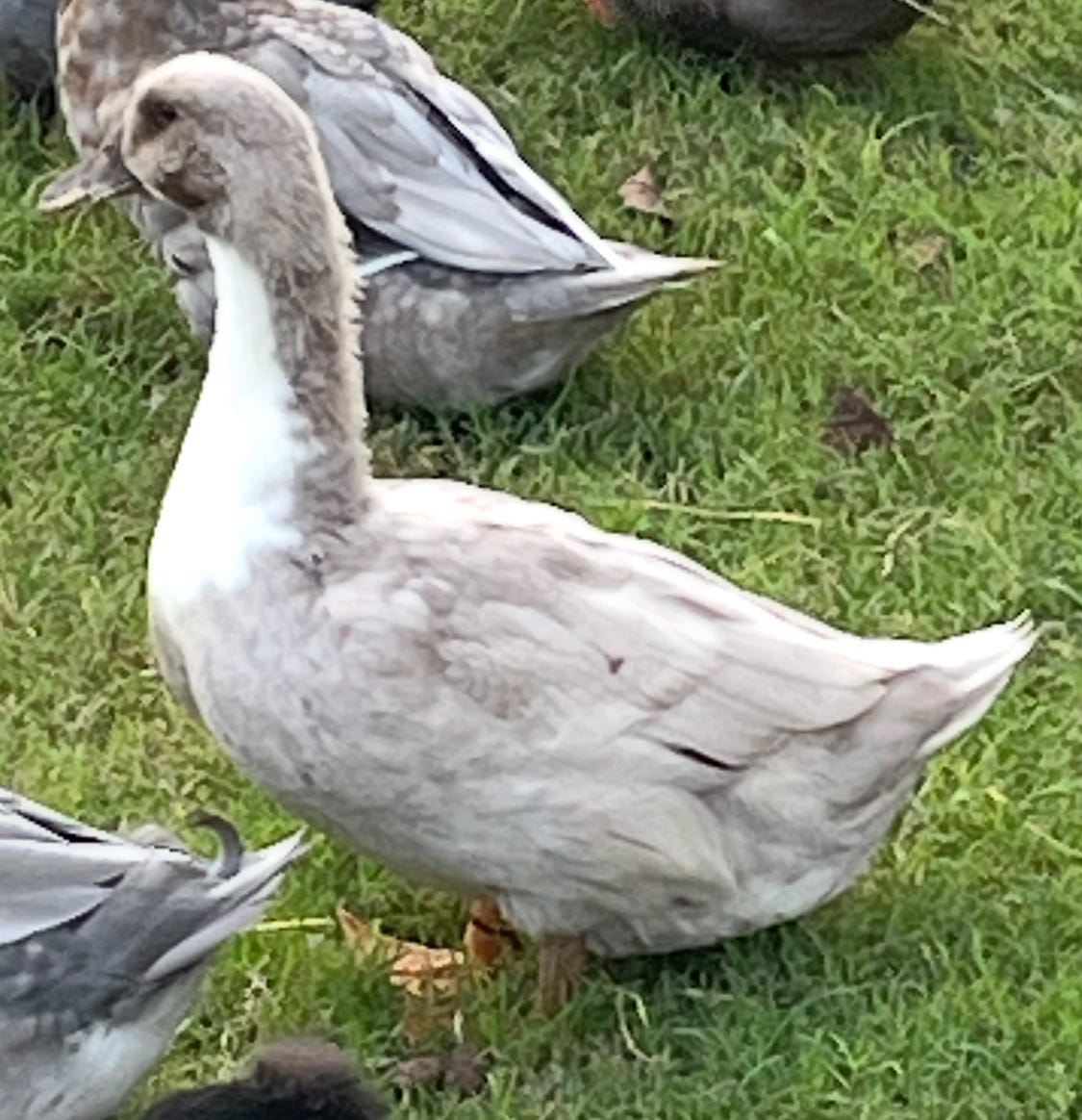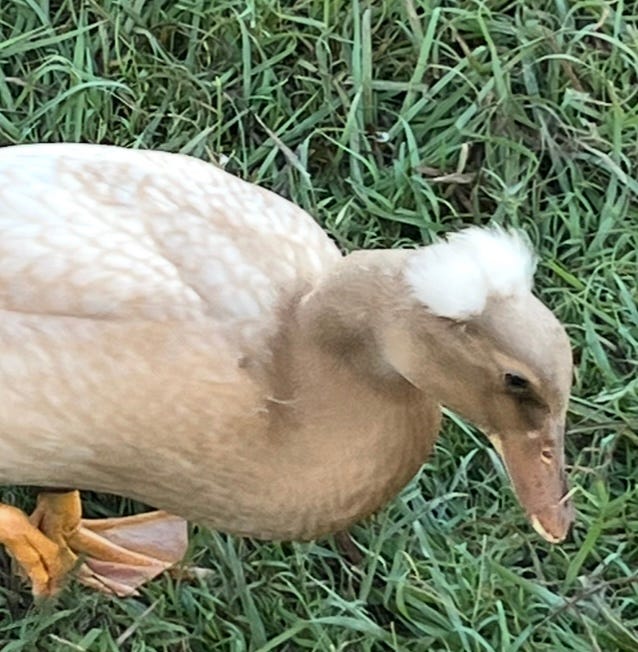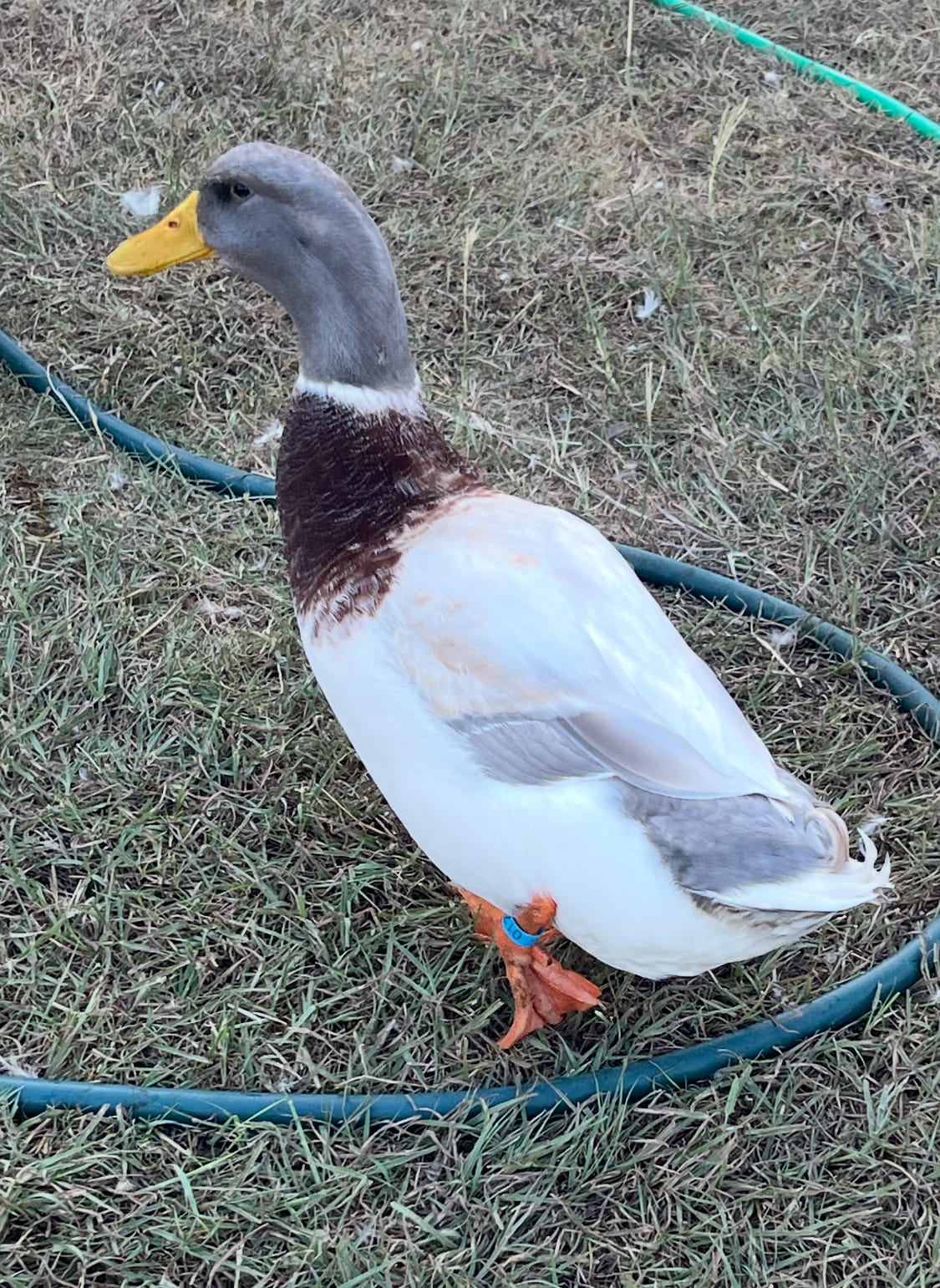Crested ducklings
Update!
Four months after hatching my very anticipated batches of *hopefully* Crested ducklings, it’s time for an update! Most mallard-based domesticated ducks mature around five months of age so we’re a little early, but there’s a lot of things to discuss and update about to wait longer.
First, the sex linked color results were 100% accurate and easy to distinguish. The mallards and blues were males, the buffs were females. And then there’s Chanel, but we’ll discuss her later under color results.
This is because of how the chocolate gene works in ducks: breeding a drake with Chocolate (in this case, my Standard Buff drakes) to a non-Chocolate duck results in sex-linked offspring. I’ve done this twice now, with my Cayuga ducks (results: Blue males, Lilac females) and with my Crested White ladies. The colors are easy to distinguish at hatch and this method is completely accurate compared to a 65-80% accuracy from vent sexing.
Now on to color results from these hatches…I rely heavily on the duck color calculator to plan my breeding, but in this case it was not accurate, or not fully so. To explain why, let’s look at certain color genes in ducks that came into play.
White is funny because two genes result in a visibly white duck that could technically be any color ‘underneath’. With Black, the chocolate gene resulted in a lightening of the base color reliably (males being darker ‘fade’ to Blue, whereas females fade to a much lighter Lilac color). After figuring out my color results with my White girls, I had to rework the calculator a LOT to come to a possible conclusion that one [or more?] of my Crested ducks is actually a Blue Bibbed ‘underneath’ her white feathers. My three Crested ladies like to lay their eggs in the same nest and other than egg size difference sometimes, there isn’t a way for me to tell the eggs apart even though I am sure which eggs came from my Cresteds vs my other females that lay individually and in separate nests. A double Black results in a Black duck, visibly and genetically (this is called Extended Black and is represented by an E genetically). A double White results in a visibly white duck, but lurking underneath are some surprise color genes which can only be teased out in her offspring. Calculating a Standard Buff drake on a Blue Bibbed female would give sex linked ducklings that fit some of the results I got, including Silver/Lilac Bibbed females, Blue Bibbed males and Black Bibbed males. I hatched a Black Bibbed duckling that ended up being male, but I thought that the dad was my Cayuga drake Getafe - on one of my Crested White ducks only results in Black Bibbed, males and females. I can assume that the odds were not favorable to hatch out the other results: a Silver Bibbed male and a Chocolate Bibbed female for the 6 possible results.
Mallard or Gray was one of the results I was supposed to get, males. At hatch, because of the dark and yellow patterning with eyestripes, I assumed this was what I got.
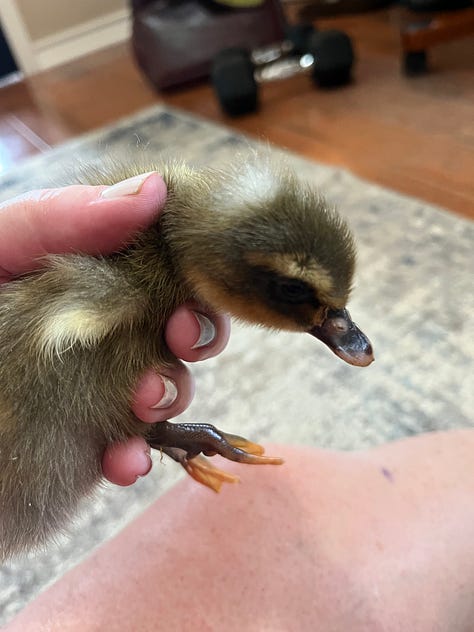
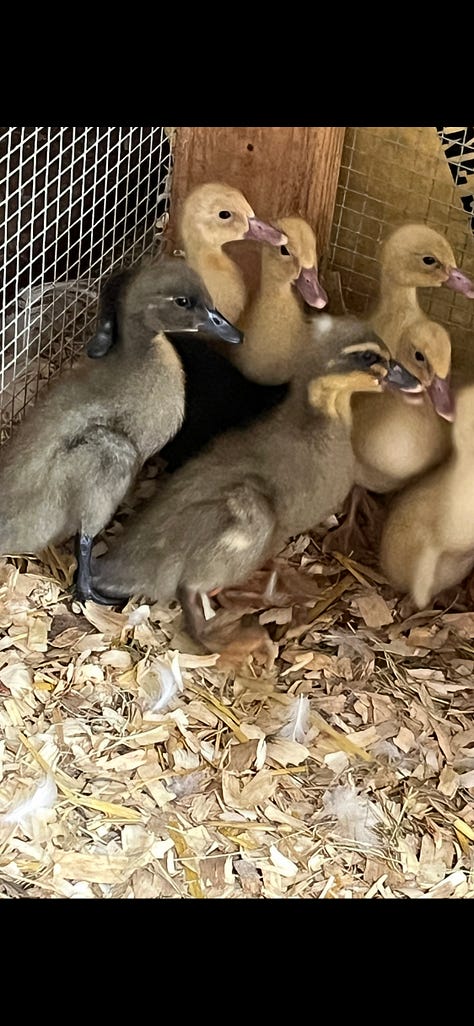
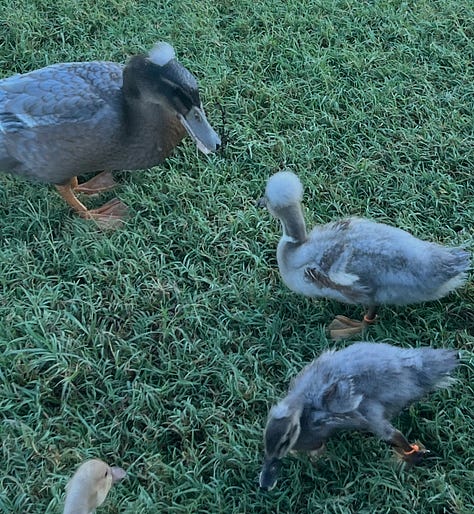
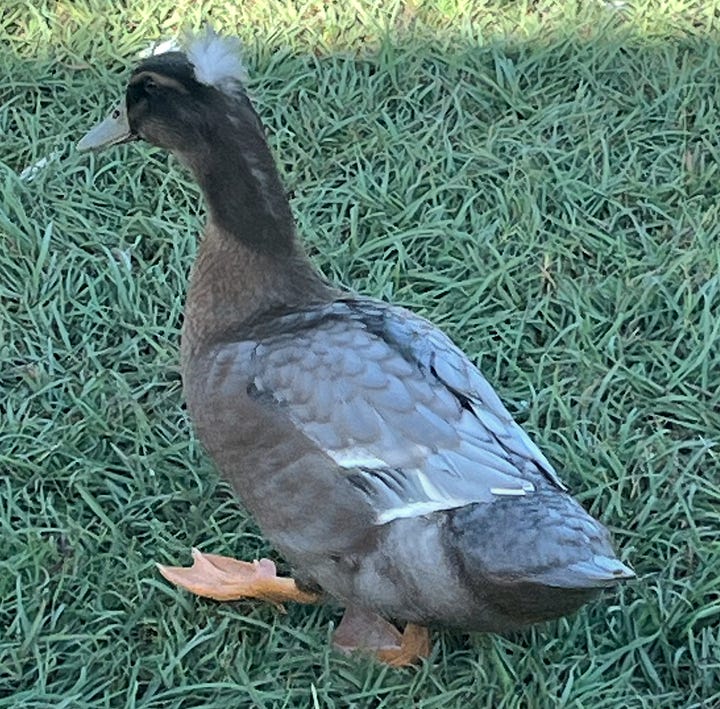
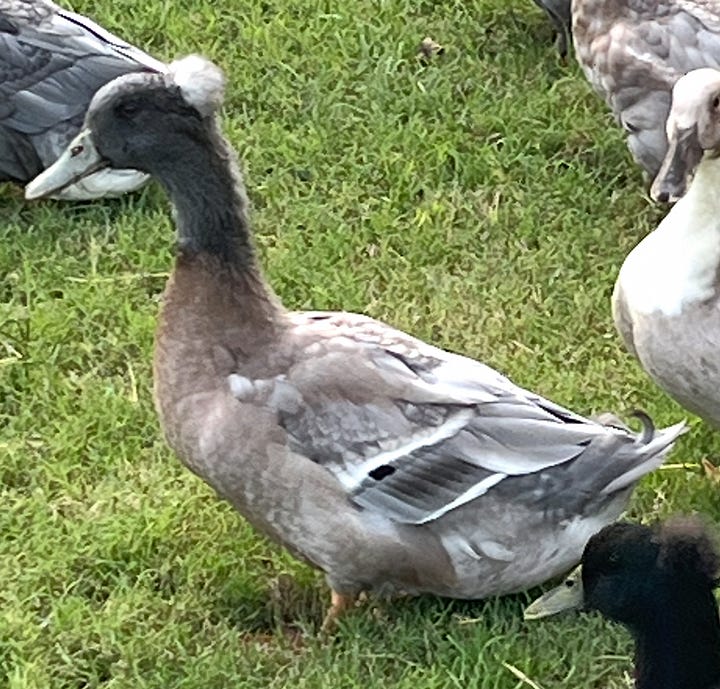
It took months for me to determine his true color pattern, because I hadn’t owned a mallard-patterned drake before and wasn’t familiar with their feather changes. Juvenile and non-breeding males have an eclipse plumage that is basically all brown, just like mallard females. Nuptial plumage is their colorful breeding feather pattern and can be several tones of colors with a mallard base pattern. Mallard/Gray in this case would be the classic green head, brown chest and silvery body. It took Borussia [pictured above, my oldest ‘mallard’ from the Crested hatches] months to develop out of his juvenile brown into finally his true color, which is actually Blue Mallard / Blue Fawn. As you can see above, when he feathered out completely, there is no green on his head, only a dark gray. Borussia is also missing the white ring around his throat, likely a result of him carrying a Dusky gene. I had a total of 7 drakes this color hatch from 3 batches, of which I will keep Borussia for breeding, along with Bob Ross:
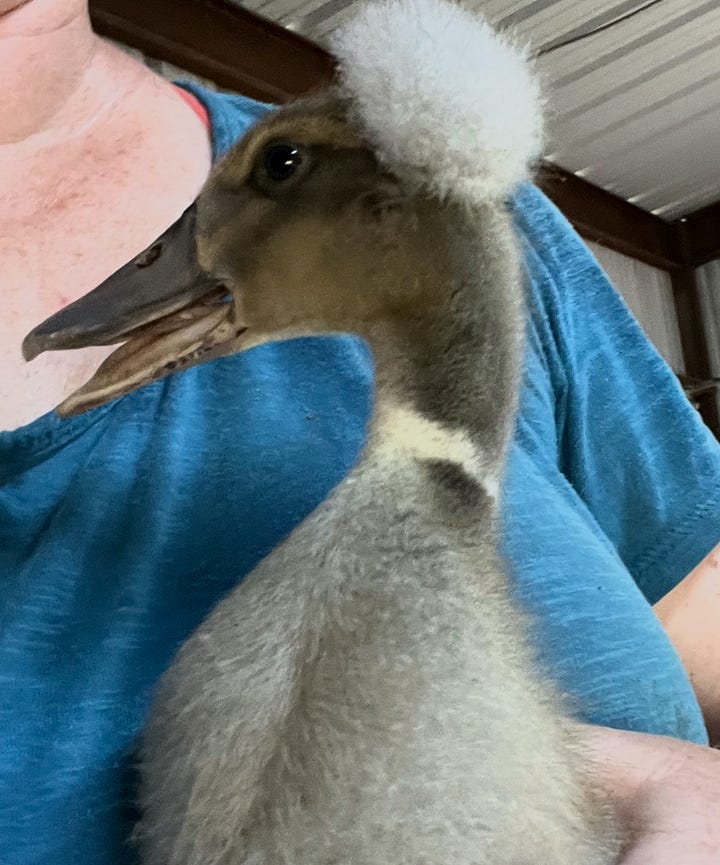
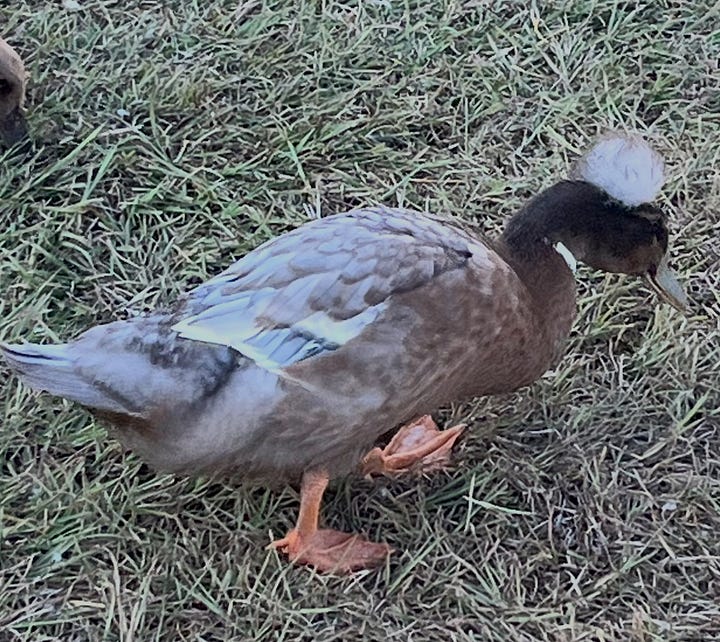
What at hatch I thought were the Blue Mallard males I wanted, ended up being Blue Bibbed [Blue Swedish]. These drakes have a dark blue head and steely blue body with a prominent white bib. Their color patterns have remained consistent from hatch to maturity, including their white belly spots they hatched with remaining the same as they feather out.
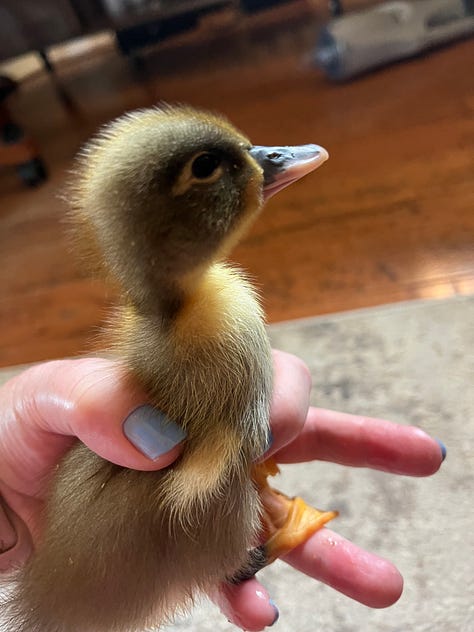
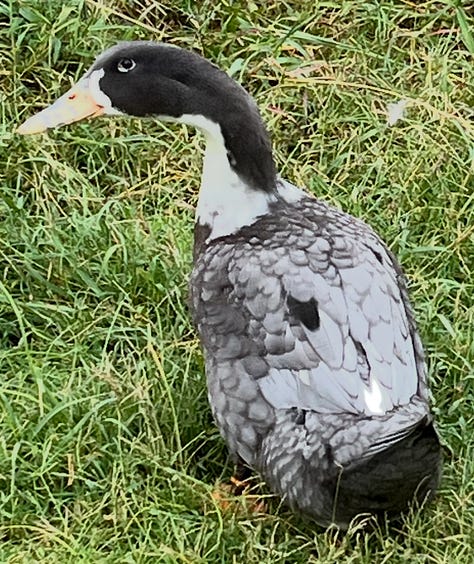
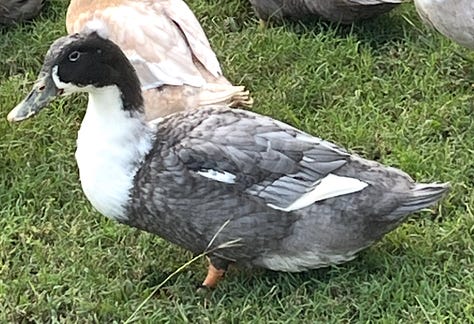
Buff mallard females were the next results, divided into Buff Chocolate or Buff Lilac. At hatch, these ducklings were yellow with variations of eyestripes and feet color, very much like Buff ducklings. I kept a few with visible crests to continue my breeding project and sold a few without visible crests. Once again, the sex-linked accuracy allowed me to confidently sell young ducklings as females and is very convenient for planning a flock. I’m glad I withheld more females than I thought I would need, since I lost my lovely duck Paris to a copperhead bite**. She had the biggest crest, a creamy Buff color pattern and was a huge loss to me personally and genetically.
So for my breeding plans from these summer hatches I have Buff mallards Gunner, Givenchy, Lauren, Lilac Burnley and Question Mark Chanel.
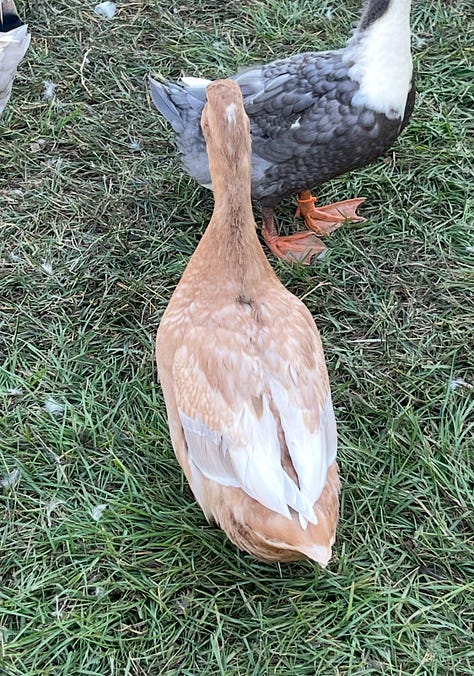
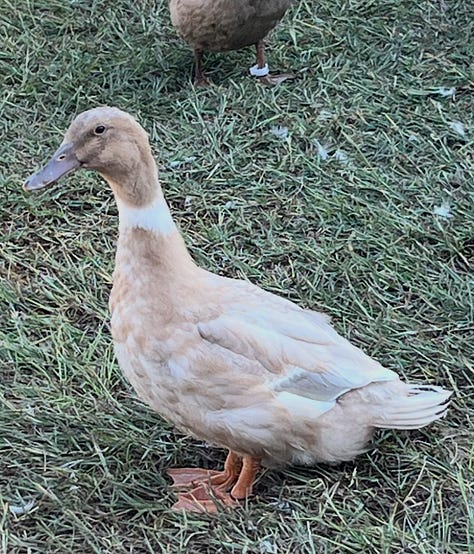
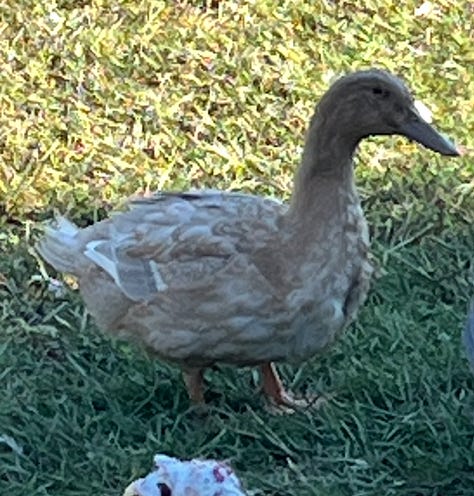
I think the pattern most closely matching the color these ladies ended up being is actually the female Blue Mallard or Apricot Mallard/Pastel which are Call duck colors. Clearly their base color is Buff, but with mallard patterning like eyestripes, throat ring and blue wing tips.
Burnley is the typical Lilac color, perhaps a smidge darker than adults Fio & Raja because she is younger and Black ducks tend to get lighter/white feathers that replace black ones as they age. These Lilacs (all from Buff drake x Cayuga duck) tend to have a brownish tinge to their coloring compared to a Silver Splash duck, which is more of a silver gray. Which brings me to my sweet question mark duckling, Chanel. I originally thought she might be ‘Buff Lilac mallard’ to all of the rest of the females I hatched ‘Buff Chocolate’…or vice versa? But she definitely isn’t Chocolate, and her color is very light silver compared to my Lilacs:
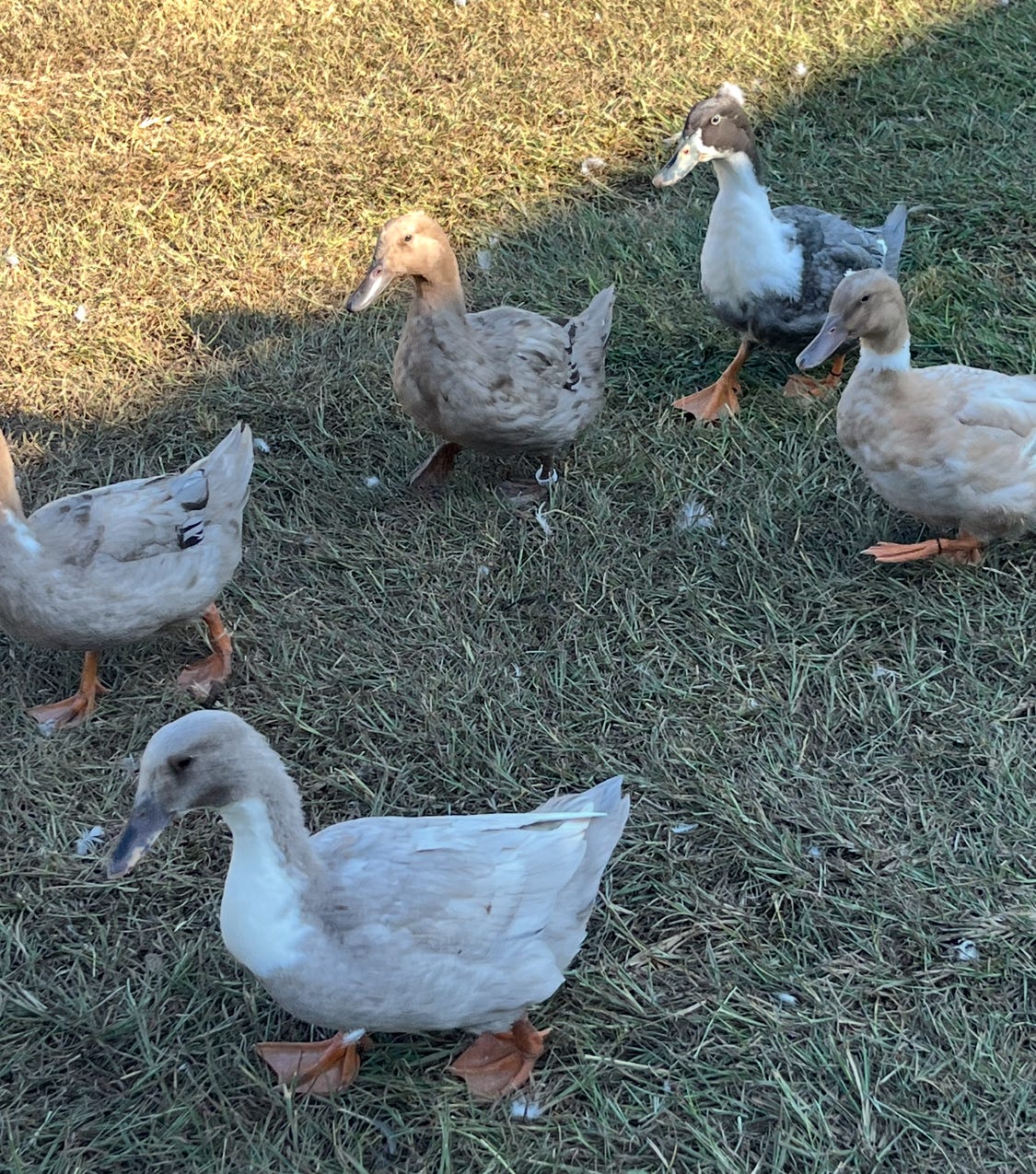
Simply looking at her color, she could be Silver/Splash, Silver Bibbed or Lilac Bibbed. None of these were options on the color calculator. She doesn’t seem to have the ‘Buff’ part of the Buff mallard predicted, either. I’ve hatched a few Silver/Splash ducklings [including the drake in the picture above from a Buff drake x Lilac duck] and enjoy comparing these ducklings, although every one is unique. This drake has an orangey bill and feet (first Silver drake I’ve hatched, so that’s probably why), a disseminated white bib and some Buff feathers tucked in amongst the mostly gray ones.
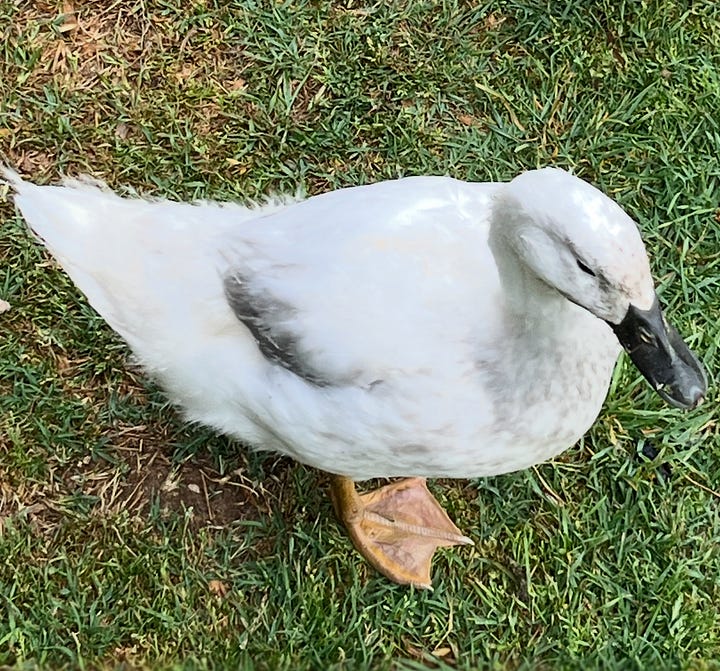
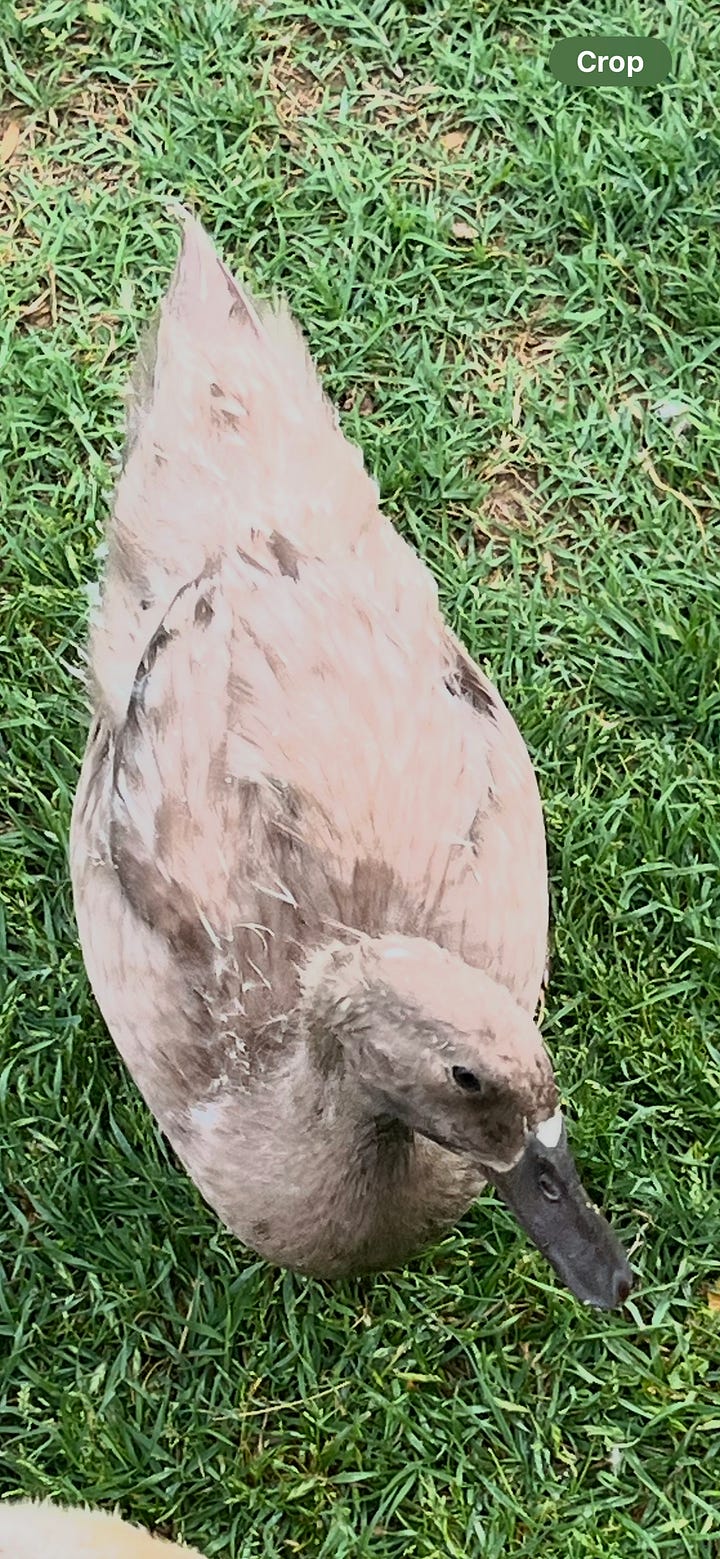
My spidey senses tell me that Chanel is actually a Silver Bibbed, but I will have to determine that based on her offspring in future breedings. The Silver is necessary to produce 100% Blues when combined with Black. Breeding Blues to Blues will give a mix of Blues, Silver and mostly Black. This applies whether solid colors or Bibbed as in Swedish ducks. Hatcheries use this strategy to be able to provide Swedish ducks in predictable amounts from these three colors by rotating the pairings. Solid Blue crested offspring from Chanel if it happens works perfectly for the Crested Black duck line since Black x Blue gives Black and Blue.
I still ended up with a colorful group of ducks, most crested and that fit with my breeding projects (Crested Black and a group that breeds Blue Mallards and Apricot Mallards). I can study and maintain breeding lines/colors based on these groups, but am also continuing to study and refine the colors as well as body size. I’m currently incubating a batch of eggs that will help with 2/3 of my fall goals: 1) Can Aurélien my Crested Cayuga pass his crest on genetically? Since his crest is a spontaneous mutation from non-Crested parents, it’s possible that he does not pass it on. 2) Check the breeding ability of my two Saxony drakes and what they pass on as far as coloring and body size [this would be a non-Crested group that would be used to improve the Blue Mallard pattern].
The third goal was to see if perhaps with time and maturity if the four Blue ducklings I hatched in the summer are actually some form of Blue Mallard instead of just being Blue Bibbed. Two were crested and two were not, and are pretty drakes, but not the color pattern I want to keep in my flock. I can wait a few more months to double check, but I really think they are Blue Bibbed and will stay the color and patterns they hatched with.
In the meantime, I will continue to use the color calculator to try and plan breedings, but always keeping the grains of salt of my experiences and dedication to longterm study of my ducks as a consideration. Having pens of ducks only for breeding purposes to fit some sort of standard or ideal has never been what I wanted to do, so I remain dedicated to achieving my flock goals while still ensuring I have free ranging, happy and healthy ducks for me and others to enjoy.
Footnotes & resources:
A fantastic explanation of genes and colors by Ducks of Providence
**This same snake attacked two other ducklings that were younger. A crested male had neurological symptoms that slowly worsened over several days and he ended up dying even though up until the last day he had been eating, drinking with assistance and pooping normally. The last day I tried to tube feed him to make sure he was getting enough fluids, but his paralysis ended up killing him. From the July hatch, I had a Lilac female from Leganés Cayuga’s gray egg (my other two adult Lilacs are daughters of my Cayuga Rayo and lay white eggs). I found her two evenings after the snake attack with a very full crop and sitting under the yard cart with her eyes closed. I brought her inside and treated her with a crop massage as well as cleaning her eyes and coating them with coconut oil to keep her eyelids from sticking. After two days and one evening inside with her own food she ate willingly, she rejoined the flock and recovered completely. I was grateful she did, since I no longer have any Buff drakes to make sex linked ducklings.
I didn’t plan or like to lose any of my Crested ducklings, but I used the opportunity to check the deceased ducks’ skull for holes, attachments or issues related to their crests. The myth that crested ducklings are unethically bred, have holes in their skulls and live miserable lives persists throughout the internet despite a lack of evidence beyond one minimal study. Finally, some additional research has started to be done (this blog post details it nicely) that doesn’t exactly address the ‘die in the shell’ part of crested eggs especially comparing it to the normal lethality in non-crested eggs. I’ve continuously said-ranted even- that there aren’t detailed studies that include bloodline diversity, natural vs acquired crests and over the natural life of Crested ducks. Based on my experiences, I think [still] that more research needs to be done to determine if the lethality and issues in Crested ducks are more compared to non-Crested ducks and anatomical studies on Crested ducks of all ages, in case ducklings can hatch with a softer area or hole in the skull that closes up with age. Studies need to be done to determine IF the trait being passed on is a hole in the skull that the body then deposits fat and feathers (the crest) on top of, since it is possible to pass on a crest without a hole, as I determined in my hatchlings. I was surprised at the size of the crests on many of my hatchlings since these were heterozygous (one Crested parent and one not Crested). The only Crested duck I’ve necropsied so far that had a hole and neurological symptoms was a young duckling (under 8 weeks old) from Tractor Supply, which generally uses Hoover’s Hatchery for their ducklings. I also regularly pick up my alive Crested ducks of different sexes and sizes to feel their crests and have yet to feel a hole or have unexplained neurological symptoms. I lost a Buff duckling (no crests or genes) in the spring to a weakness/wasting away disease that was either botulism or ‘hardware disease’, but both are speculation. None of the other ducklings in its large group even got ill under all of the same living conditions, so botulism doesn’t seem likely unless this particular duckling had a weaker immune system than the others.



